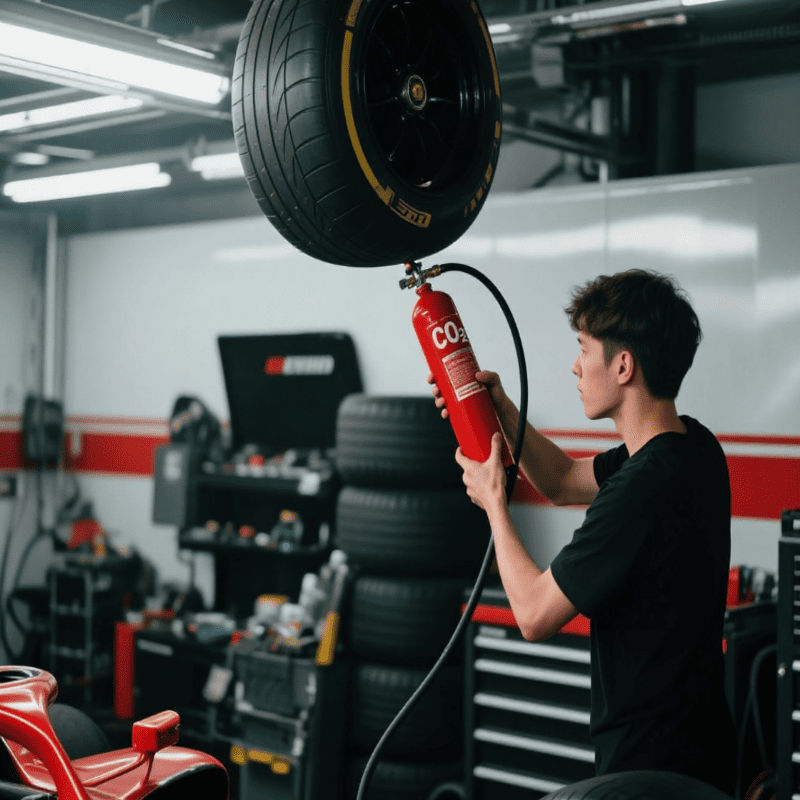Inflated Tire

1.The Role of CO₂ Cylinders in Inflated Tires:
(1)Rapid Inflation: The gas inside the CO₂ cylinder is under high pressure. When connected to the tire inflation port and the valve is opened, CO₂ can quickly fill the tire, enabling the tire to reach the required air pressure within a short ti me. It is especially suitable for situations where emergency inflation is needed. For example, when a tire suddenly leaks air in the wild, it can quickly restore a certain air pressure in the tire, allowing for continued driving.
(2)Stable Air Pressure: CO₂ gas has relatively stable properties and is less affected by temperature changes. Compared with air, tires filled with CO₂ can maintain more stable air pressure under different ambient temperatures, which helps to improve tire performance and safety and reduces problems such as uneven tire wear and tire bursts caused by air pressure fluctuations.
(3)Dry and Clean: CO₂ gas is usually quite dry and contains no moisture or impurities. It will not form condensed water inside the tire like the water vapor in ordinary air, thus avoiding problems such as internal rusting of the tire and rubber aging caused by moisture, which is conducive to extending the service life of the tire.
2.Selecting the Correct Weight:
Select a CO₂ cylinder with an appropriate capacity and pressure according to the size of the tire and the required air pressure. A 16-gram CO₂ cylinder belongs to the small-capacity specification, and its inflation volume is relatively small. It is very suitable for inflating bicycle tires and small electric vehicle tires, or for making a small amount of additional inflation for car tires in case of an emergency. For example, when a bicycle tire has a slight air leak, the cyclist doesn't need to look for an inflation station. Using a 16-gram CO₂ cylinder can quickly restore the tire's air pressure and ensure a smooth journey.

3.Correct Installation and Use of CO₂ Cylinders for Inflating Tires
Installing the CO₂ Cylinder:
(1) Select the appropriate CO₂ cylinder and inflation device: Select a CO₂ cylinder with an appropriate capacity and pressure according to the size of the tire and the required air pressure. Common CO₂ cylinder capacities include 16 grams, 20 grams, 25 grams, etc. At the same time, ensure that the inflation device is compatible with the CO₂ cylinder, generally including components such as the valve stem, valve, and pressure gauge.
(2)Check the cylinder and inflation device: Before installation, carefully check whether the CO₂ cylinder is damaged, leaking, etc. Check whether all components of the inflation device are in good condition, whether the valve stem can work properly, and whether the pressure gauge is accurate.
(3)Connect the cylinder and the inflation device: Place the CO₂ cylinder steadily, then align the valve stem of the inflation device with the valve interface of the cylinder. According to the instructions for using the inflation device, rotate the valve stem clockwise or tighten the connecting components to ensure a firm connection and no air leakage.
Using the CO₂ Cylinder for Inflation:
(1)Preparation work: Park the vehicle in a flat and safe place, engage the handbrake, turn on the warning lights, and place a triangular warning sign to prevent collisions with other vehicles. If inflating a bicycle tire, secure the bicycle to keep it stable.
(2)Loosen the tire valve cap: Locate the tire valve stem, rotate the valve cap counterclockwise, remove it and place it properly to avoid losing it.
(3)Connect the inflation device to the tire valve stem: Align the valve stem of the inflation device with the tire valve stem after the CO₂ cylinder has been installed, press it firmly and rotate it to make a tight connection. Some inflation devices may require pressing the locking button or rotating the adjustment knob to fix the valve stem.
(4)Check the tire air pressure standard: Understand the standard air pressure value of the tire through the vehicle's user manual, the markings on the side of the tire, or other relevant information. Generally, the air pressure of car tires is between 2.2 - 2.5 kPa, the air pressure of SUV tires is slightly higher, and the air pressure of bicycle tires is between 200 - 800 kPa depending on the type.
(5)Inflation operation: Open the valve of the CO₂ cylinder to let the gas fill the tire. During the inflation process, pay close attention to the pressure gauge on the inflation device. When the air pressure approaches the standard air pressure value of the tire, slow down the inflation speed. The inflation volume can be controlled by intermittently opening and closing the valve until the accurate air pressure value is reached.
(6)Complete the Inflation: After reaching the required air pressure, close the valve of the CO₂ cylinder, then remove the inflation device from the tire valve stem, and quickly screw the valve cap back onto the tire valve stem to prevent dust and debris from entering the valve stem.
If you are interested in the specific details of the various weights of our CO₂ cylinders, you can click the link below to learn more.
| 16-gram threaded CO₂ cylinder |


